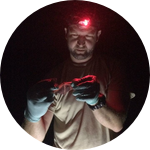
Eric Green
Indian Head, Saskatchewan, Canada
North American Society for Bat Research, American Society of Mammalogists, Southwestern Association of Naturalists, The Wildlife Society
More
Haven't backed any projects yet!
Results are in!
Hey everyone! I just wanted to let you know that I've posted some results to the project. I thought it would send out a notification when I did so, but it didn't. Click the link to go to the projec...
Lab Work to Begin Soon!
Welcome back! After a long summer of completely-unrelated field work (so I could keep a roof over my head), I'm back at school. This semester, I'm focusing all of my attention on fi...
Specimen Collection 2
Over the past few weeks, I've had someone from the state of Arizona collecting coyote specimens for me. During the first three weeks, this effort yielded 43 skin snips and 37 whole ...
Next Steps
Hi backers and other interested parties! It's been a few weeks since this project was fully funded, so I wanted to let you all know where we are and where we're going. The check has arrived, and we...
Almost There!
Hi Backers!I just wanted to let you know that we're close to being fully funded, but we need your help!We only have 11 days left in the campaign, and we need to raise $238 to reach our final goal. ...
Matching Goal Achieved!
Hi everyone! I just wanted to write a quick update and let you know that we made the intermediate goal for the matching donation... 4 times over! You guys rock!Thanks to everyone who has supported ...
$275 Matching Donation - Now through Sunday
Great news! An anonymous conservation-oriented organization has offered to match all donations up to $275 that we bring in through Sunday at midnight! Now through the weekend, your ...
Specimen Collection 2
Later this spring, we'll be working with the Arizona Game and Fish Department to collect additional coyote specimens. The department carries out predator culling initiatives annually to reduce coyo...
